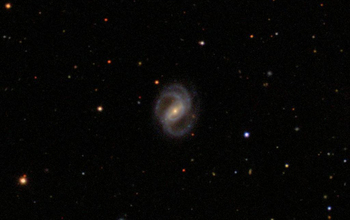Multimedia Gallery
Researchers publish catalog of galaxies (Image 3)
This galaxy, UGC 8467, was identified by the Galaxy Zoo 2 project as being a spiral galaxy with a bar -- a long extension of bright stars going through the center of the galaxy -- and three spiral arms of medium tightness. Three-armed spiral galaxies are relatively rare in the universe, but are of scientific interest due to predictions that relatively long timescales are needed to generate this pattern. [Image 3 of 6 related images. See Image 4.]
More about this image
Galaxy Zoo 2 is the second phase of a crowdsourcing effort to categorize galaxies in our universe.
Researchers already know computers are good at automatically measuring the properties -- such as size and color -- of galaxies but more challenging characteristics, such as shape and structure, can currently only be determined by the human eye. So, between February 2009 and April 2010, more than 83,000 Galaxy Zoo 2 volunteers from around the world looked at images online, gathered from the Sloan Digital Sky Survey. They answered questions about different galaxies, including whether they had spirals, the number of spiral arms present, or if they had galactic bars -- long, extended features that represent a concentration of stars. Each image was classified an average of 40-45 times to ensure accuracy. More than 16 million classifications of more than 300,000 galaxies were gathered representing about 57 million computer clicks.
Next, an international group of researchers, led by the University of Minnesota, produced a catalog of the new galaxy data. The catalog is 10 times larger than any previous catalog of its kind and is available online at https://data.galaxyzoo.org/.
The National Science Foundation (NSF) provided funding for both the Sloan Digital Sky Survey, to gather the images, and the Galaxy Zoo project, to categorize them (NSF grants DRL 09-41610 and AST 08-02876).(Date image taken: 2009-2010; date originally posted to NSF Multimedia Gallery: Aug. 18, 2017)
Credit: Sloan Digital Sky Survey (SDSS) Collaboration/http://www.sdss3.org
Images and other media in the National Science Foundation Multimedia Gallery are available for use in print and electronic material by NSF employees, members of the media, university staff, teachers and the general public. All media in the gallery are intended for personal, educational and nonprofit/non-commercial use only.
Images credited to the National Science Foundation, a federal agency, are in the public domain. The images were created by employees of the United States Government as part of their official duties or prepared by contractors as "works for hire" for NSF. You may freely use NSF-credited images and, at your discretion, credit NSF with a "Courtesy: National Science Foundation" notation.
Additional information about general usage can be found in Conditions.
Also Available:
Download the high-resolution JPG version of the image. (361.6 KB)
Use your mouse to right-click (Mac users may need to Ctrl-click) the link above and choose the option that will save the file or target to your computer.

